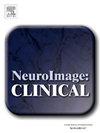3T弥散张量成像诊断成人急性外伤性臂丛神经损伤的根撕脱
IF 3.4
2区 医学
Q2 NEUROIMAGING
引用次数: 0
摘要
背景外伤性臂丛神经损伤(tBPI)患者的根撕脱是常见的,MRI用于帮助识别需要紧急重建的患者。弥散张量核磁共振成像(DTI)产生神经“健康”的替代措施,对髓鞘形成、轴突直径、纤维密度和组织都很敏感。这项前瞻性多中心试点研究评估了DTI在急性创伤性臂丛损伤成人中检测根撕脱的效用。方法在3特斯拉时行DTI。从脊神经根提取各向异性分数(FA)和径向扩散系数(RD)。术前自发恢复的参照标准为手术探查或监测。采用线性方法比较脊神经根撕脱、不连续性脊神经根和对侧未损伤脊神经根,并计算95%置信区间(CI)。结果14例tBPI男性患者(平均年龄44岁,SD 14)在损伤后平均18天进行扫描(CI 15-21)。撕脱根的扩散更具有各向同性;根撕脱比不连续性根损伤的FA低12% (CI 5-19),比对侧未损伤的FA低14% (CI 7-21)。同样,撕脱根的径向扩散率高于损伤的非连续性根(平均差值0.30 x10−3 mm2/s [CI 0.01 - 0.60])和对侧未损伤根(平均差值0.36 x10−3 mm2/s [CI 0.7 - 0.64])。结论弥散张量成像对成人tBPI撕脱根远端残根早期显微结构变化较为敏感。DTI可以作为形态学MRI的补充,更好地识别需要早期重建的患者。本文章由计算机程序翻译,如有差异,请以英文原文为准。
Diffusion tensor imaging at 3T for diagnosing root avulsion in adults with acute traumatic brachial plexus injuries
Background
Root avulsion in patients with traumatic brachial plexus injury (tBPI) are common and MRI is used to help identify patients who need urgent reconstruction. Diffusion tensor MRI (DTI) generates proxy measures of nerve ‘health’ which are sensitive to myelination, axon diameter, fibre density and organisation. This prospective multicentre pilot study assessed the utility of DTI for detecting root avulsion in adults with acute traumatic brachial plexus injury.
Methods
Patients underwent DTI at 3 Tesla. Fractional anisotropy (FA) and radial diffusivity (RD) were extracted from spinal nerve roots. The reference standard was surgical exploration or surveillance if spontaneous recovery occurred preoperatively. Comparisons were made between spinal nerve root avulsions, in-continuity roots and the contralateral uninjured roots, using linear methods and 95% confidence intervals (CI) were computed.
Results
14 males with tBPI (mean age 44 years, SD 14) were scanned at a mean 18 days post-injury (CI 15–21). Diffusion was more isotropic in avulsed roots; root avulsions had 12 % lower FA than injured in-continuity roots (CI 5–19) and 14 % lower FA (CI 7–21) than the contralateral uninjured side. Similarly, avulsed roots had higher radial diffusivity than injured in-continuity roots (mean difference 0·30 x10−3 mm2/s [CI 0·01–0·60]) and contralateral uninjured roots (mean difference 0·36 x10−3 mm2/s [CI 0·7–0·64]).
Conclusions
Diffusion tensor imaging appears to be sensitive to early microstructural changes in the distal stumps of avulsed roots in adults with tBPI. DTI may supplement morphological MRI to better identify patients who need early reconstruction.
求助全文
通过发布文献求助,成功后即可免费获取论文全文。
去求助
来源期刊

Neuroimage-Clinical
NEUROIMAGING-
CiteScore
7.50
自引率
4.80%
发文量
368
审稿时长
52 days
期刊介绍:
NeuroImage: Clinical, a journal of diseases, disorders and syndromes involving the Nervous System, provides a vehicle for communicating important advances in the study of abnormal structure-function relationships of the human nervous system based on imaging.
The focus of NeuroImage: Clinical is on defining changes to the brain associated with primary neurologic and psychiatric diseases and disorders of the nervous system as well as behavioral syndromes and developmental conditions. The main criterion for judging papers is the extent of scientific advancement in the understanding of the pathophysiologic mechanisms of diseases and disorders, in identification of functional models that link clinical signs and symptoms with brain function and in the creation of image based tools applicable to a broad range of clinical needs including diagnosis, monitoring and tracking of illness, predicting therapeutic response and development of new treatments. Papers dealing with structure and function in animal models will also be considered if they reveal mechanisms that can be readily translated to human conditions.
 求助内容:
求助内容: 应助结果提醒方式:
应助结果提醒方式:


